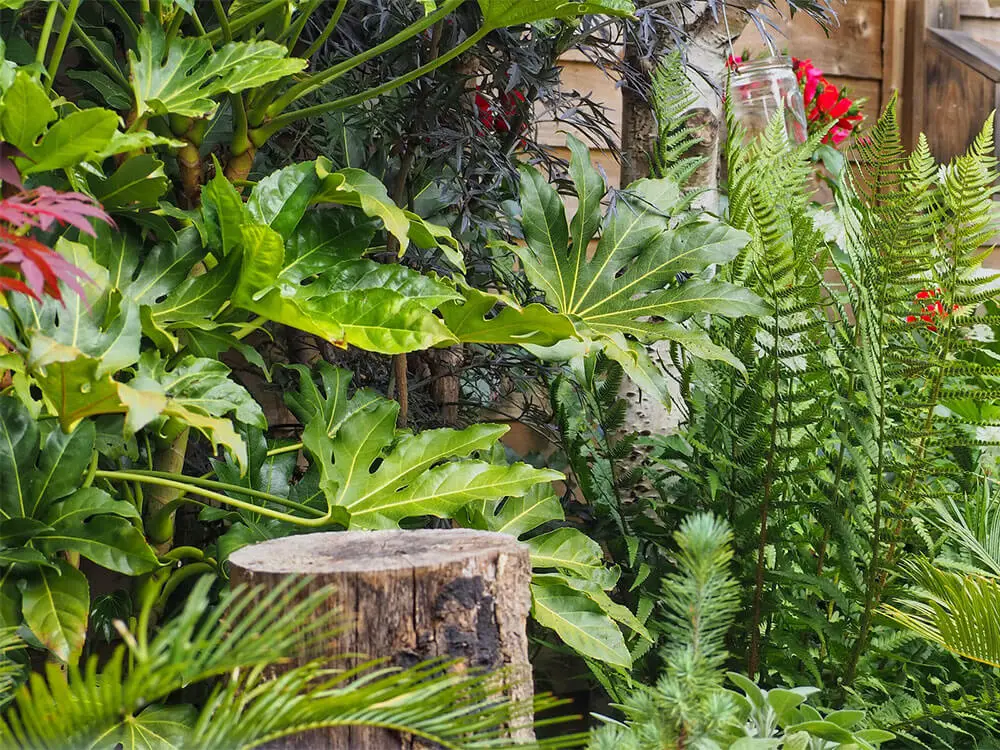How to Brighten a Small Shady Garden
February, 2023 |In mini garden spaces, it’s common to find that sunlight is restricted. Whether that’s because your balcony faces north. You’re surrounded by tall buildings. Or your neighbors have huge, densely branched trees throwing shade.
Luckily there is an amazing variety of colorful plants that you can use, and some handy tricks to brighten a small shady garden!
Whether you’ve moved house and are looking to create your own style, or you’re hoping to inject some life into a dull, shadowy garden space.
As you begin to read plant labels at the local nursery, you may find that many of them require full sun. So what do you do when your garden is in deep shade throughout the day?

Brightening a small shady garden
If your small garden faces due north and is shaded by surrounding buildings or trees, don’t be disheartened. There are plenty of ways to create a small but vibrant garden oasis!
Below we’ve included 8 tips that will help you increase light or brighten up your mini garden space.
1. Choose vibrant and interesting plants
A great way to liven up a shady space is to choose brightly colored plants that can tolerate shade. We’ve included some of our favorites below…
Annual flowers:
- Campanula: a real favorite of ours. Most varieties grow well in shade and can add a beautiful splash of purple to a small garden space.
- Hellebores: There are lots of beautiful, dusky-colored varieties to choose from. They’re perfect for small partially shaded gardens.

Perennial flowers:
- Foxgloves: Native to shady woodlands, they can bring in some amazing spires of pink and purple tones.
- Cyclamen: Low-growing, bright pink flowers that are perfect for shady containers.

Perennials:
- Hostas: The beautiful, architectural leaves of hostas can add lush texture to a small garden. Plus, there are some colorful varieties to choose from like the variegated ‘Fire and Ice’ or ‘Magic Island’.
- Ferns: There are certain species with beautiful colored leaves like the Japanese-painted fern or Autumn fern. Depending on the variety and your garden climate some ferns will be evergreen like the Japanese holly fern (Cyrtomium falcatum).
Evergreen perennials:
- Dwarf conifers: To keep your small garden space looking lush and colorful year-round, dwarf conifers are a must-have! Some of our favorite varieties include ‘Blue Star’ Juniper and the ‘Snow White’ conifer.
- Camellia: A beautiful evergreen that thrives in heavily dappled shade. Only hardy to around 10 degrees Fahrenheit.
- Fatsia japonica: Large, exotic-looking leaves that stay all year round. It thrives in heavily shaded gardens. Fatsia ‘Spiders Web’ is a beautiful variegated variety.
Check out our extensive list of shade loving plants for more ideas and inspiration.

2. Paint walls or fences
Painting the boundary of your garden in bold colors can really brighten up a small space. Just make sure you double-check with a landlord or neighbor before painting.
Bold colors are a common feature in a Moroccan style garden. Opt for colors like azure blue to add a splash of color or terracotta orange to add warmth.
You could also simply paint walls or fences in white to maximize how much sunlight is reflected onto your plants.

3. Add lighting
In a shady garden where you can’t enjoy the sunset, you could instead bask in the glow and ambiance of your own light display.
Fairy lights, solar lanterns, and any form of light can add a warming glow to a small garden space. Try and opt for ‘warm’ white lights, as these will create a more cozy and inviting atmosphere.

4. Choose colorful pots and containers
As well as choosing brightly colored plants, adding vibrant planters is another great way to brighten your garden.
Warm colors like yellow, and terracotta are great for brightening small spaces. But for an interesting contrast, purple, blue, or white containers can really draw the eye and brighten up a particularly shady corner.
5. Prune or remove plants that block the sun
If you can, prune back or remove large trees that are blocking sunlight from entering your garden. For larger trees, you’ll probably need to hire someone to help.
If your neighbor has tall, dense plants or trees blocking lots of sunlight, the law generally states that you can only trim branches that are on your side of the boundary. Though make sure you chat with your neighbors beforehand to give them a heads-up!

6. Give plants the best soil
If sunlight is minimal, the next best thing you can do to help plants thrive is to improve the soil.
Raised borders and containers are a good option if you have lots of clay in your garden soil. You may simply find that there are large rocks that stop you from digging down, so containers are a must.
In a container, you have full control over the soil conditions. So double-check your plant’s soil needs before adding plants.
Planting in containers also gives you lots of flexibility to move plants around. Especially if you’d really like to include a more sun-loving plant that you could move to follow the sun as the seasons change.
Providing the best soil for your plants will give them more vibrancy and color and help them thrive.

7. Positioning plants
Pruning and keeping plants at a manageable height is crucial for allowing as much sunlight in as possible. But positioning is also key to letting light into your space.
When you’re positioning plants, make sure you’re aware of how the sun tracks across the sky. This usually changes throughout the seasons, with less sun in winter (in the northern hemisphere).
Make sure you position any fruit or vegetable plants in the sunniest part of your garden space. Creating a vertical vegetable garden is a great way to maximize sunlight hours by physically lifting plants into a higher position that gets more sunlight.
Double-check the growing conditions of plants before you buy to make sure you have them in the best possible space. For example, a shade-loving fern could be moved out of partial sunlight to make way for a sun-loving dahlia.

8. Embrace the shade with a tropical-inspired paradise
Another fantastic alternative is to really lean into the shady environment you have by creating your own tropical ‘forest’ garden. The forest floor of a jungle rarely sees sunlight, so you could recreate your own tropical paradise with plants that love the shade. It’s a really popular small garden style for shady spaces.
A small enclosed garden can even create a mini micro climate. So if you live in cooler areas, you might find that you can push the limits of the hardiness rating of some plants.
Some lush, tropical-looking plants that don’t mind the shade include:
- Fatsia japonica
- Ferns
- Begonias
- Heucheras
- Impatiens
- Cold hardy banana plants
Make the most of vertical space too, use vibrant plants and decor, add some lighting, and embrace the shade by creating your own mini tropical paradise!

The benefits of a shady garden
There is an incredible variety of shade-loving plants that you can include in your shady garden. Being limited to shade-loving plants can actually help you keep your garden looking more cohesive. These plants often have amazing architectural leaves and colors which can pair exceptionally well together.
In warmer climates, a north-facing, shady garden can be beneficial as it stays shady and cool. But in cooler areas, and especially if you’re trying to grow crops, a south-facing garden might be preferable.
Growing crops in a shady garden
Most fruiting plans will need at least 6-8 hours of sunlight. But there are some great shade tolerant crops that you could try growing!
Featured Image: Photo by Adam Anderson on Unsplash






